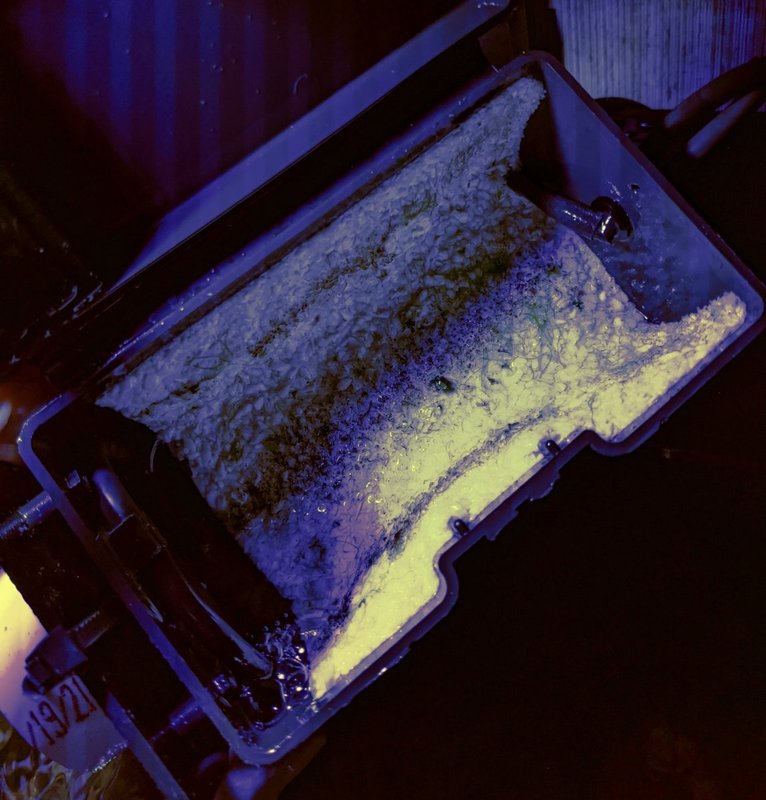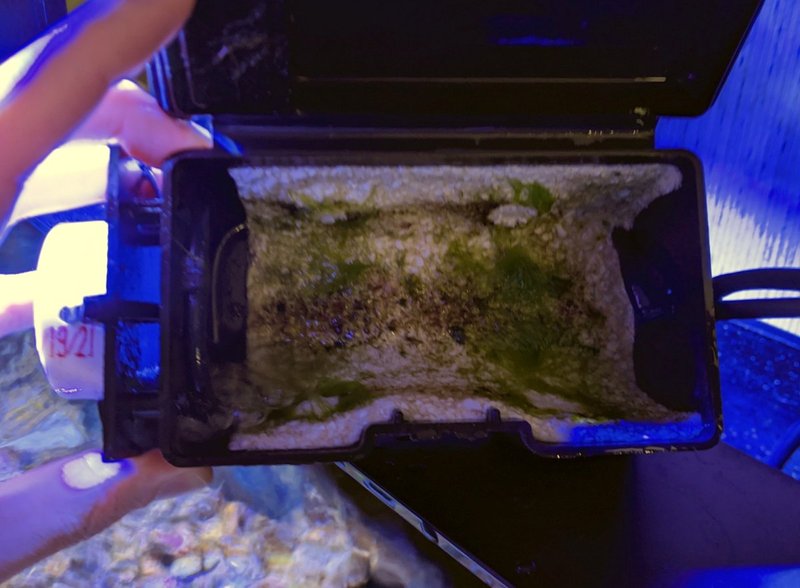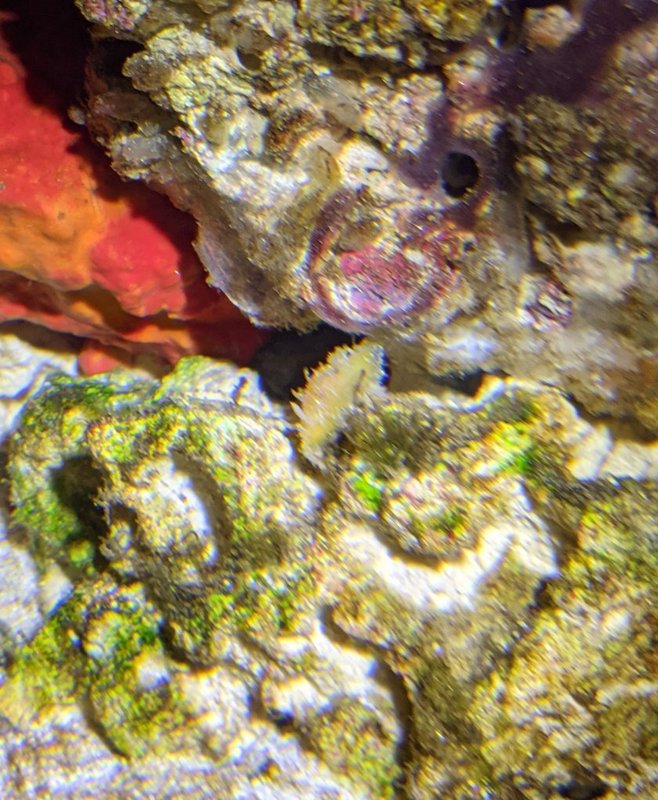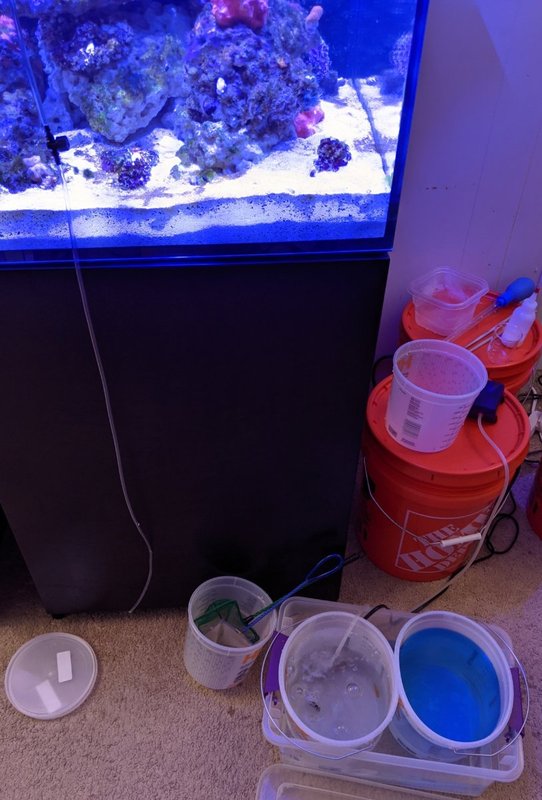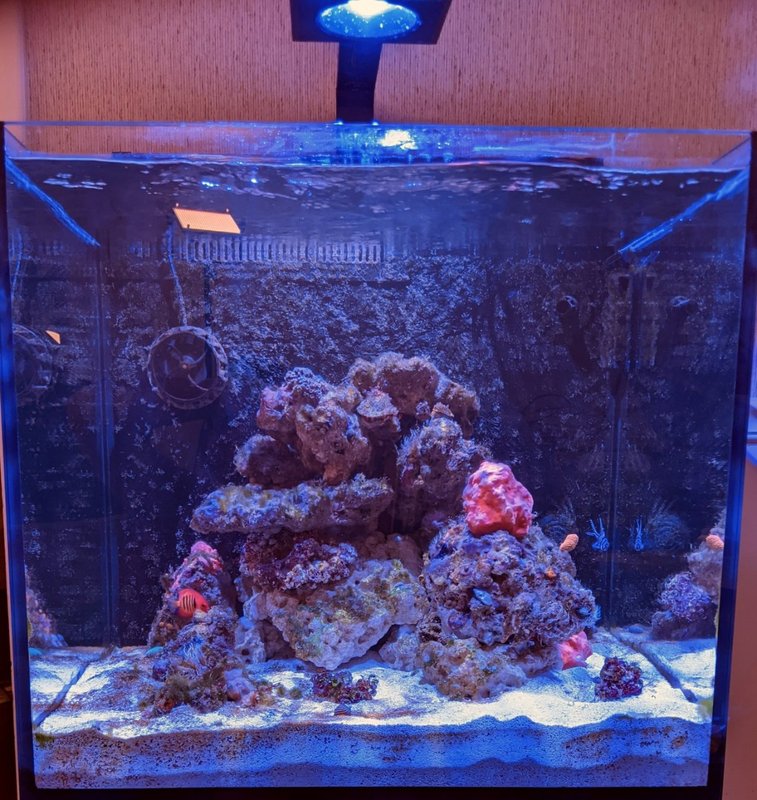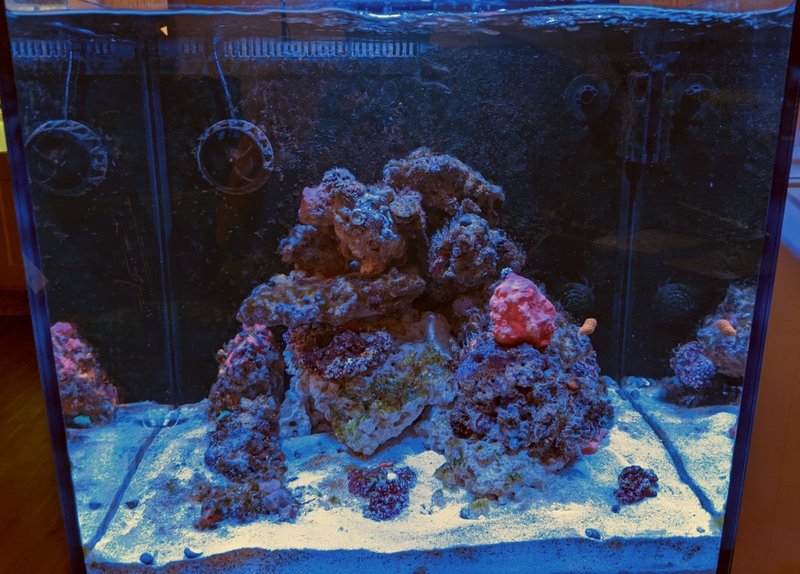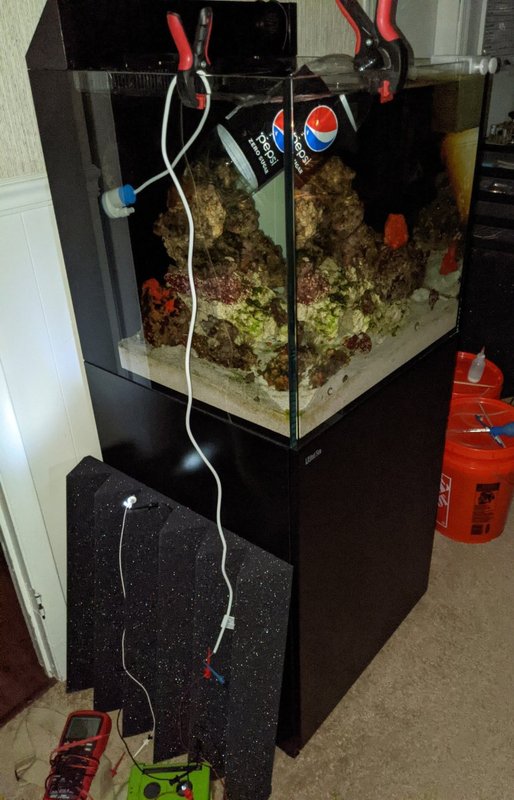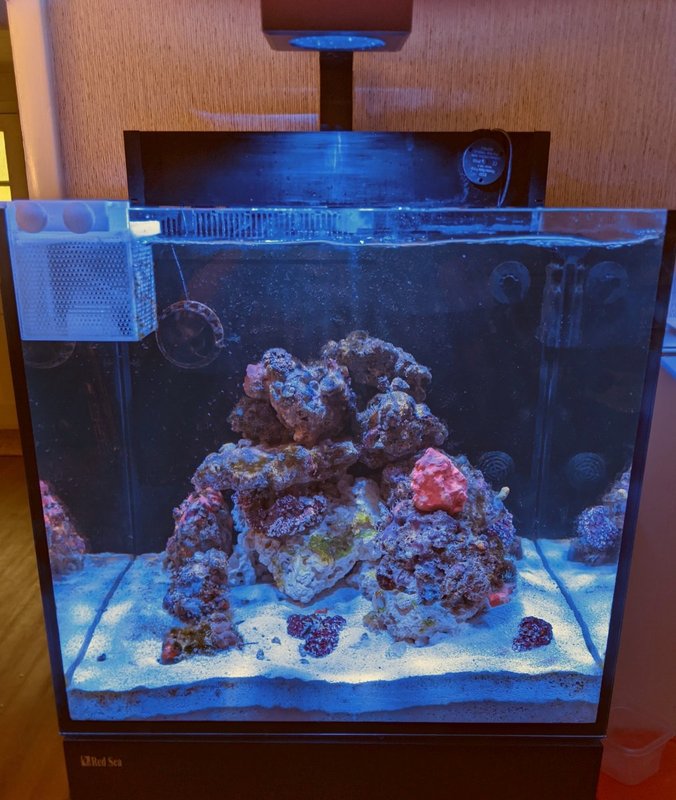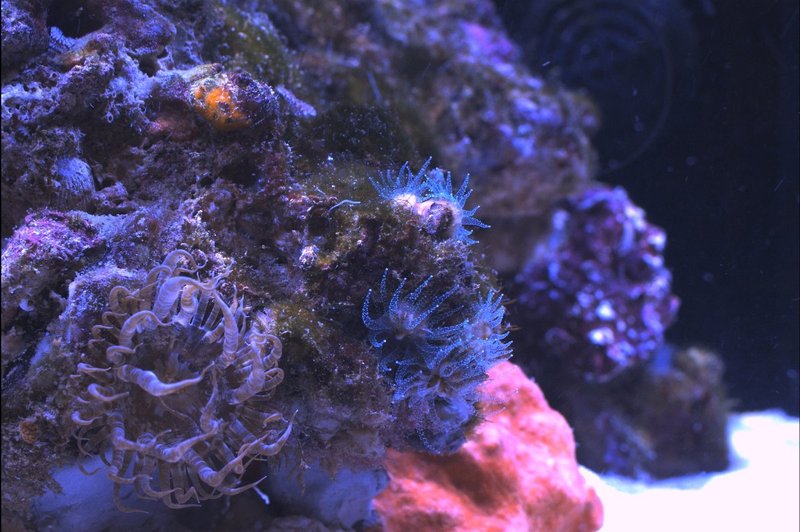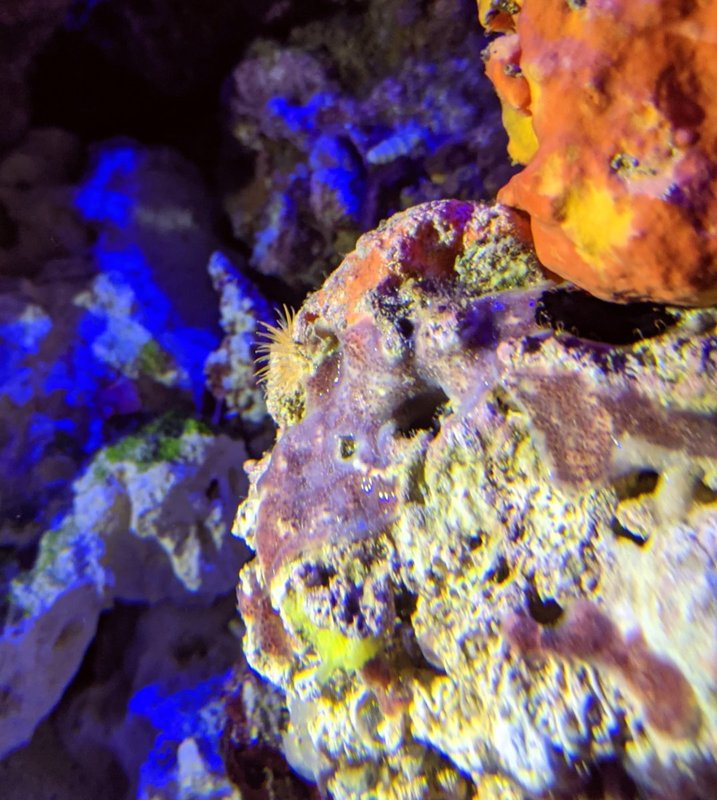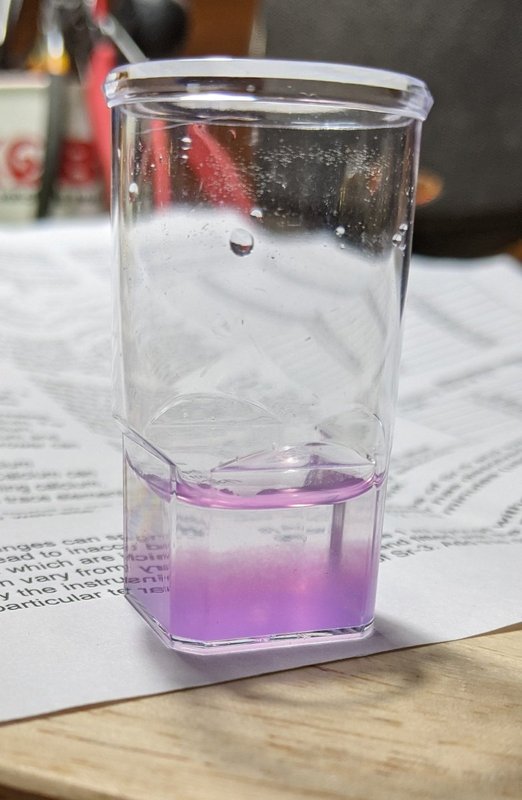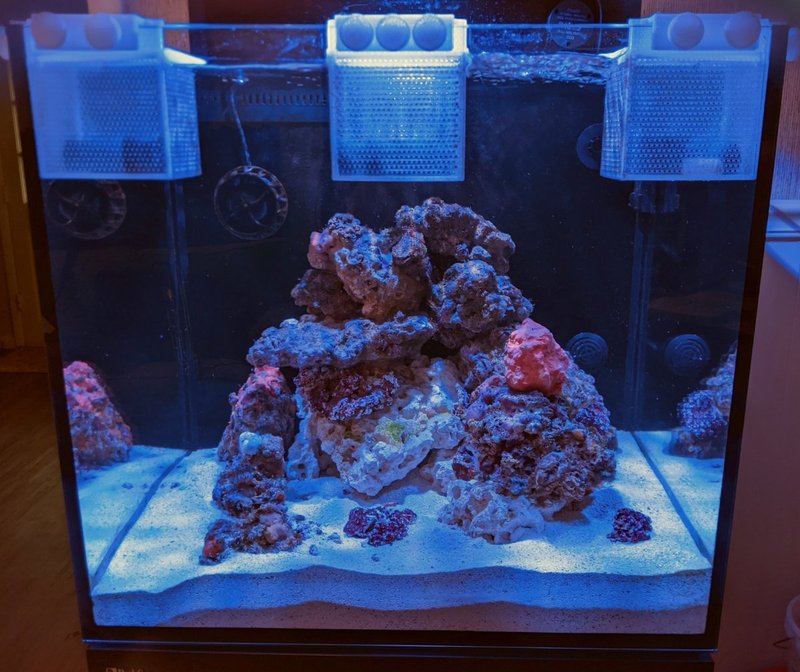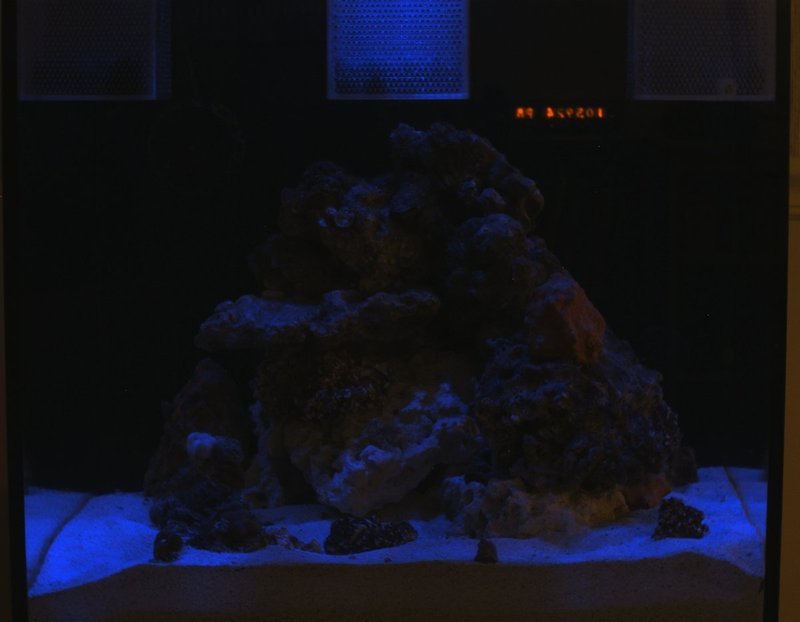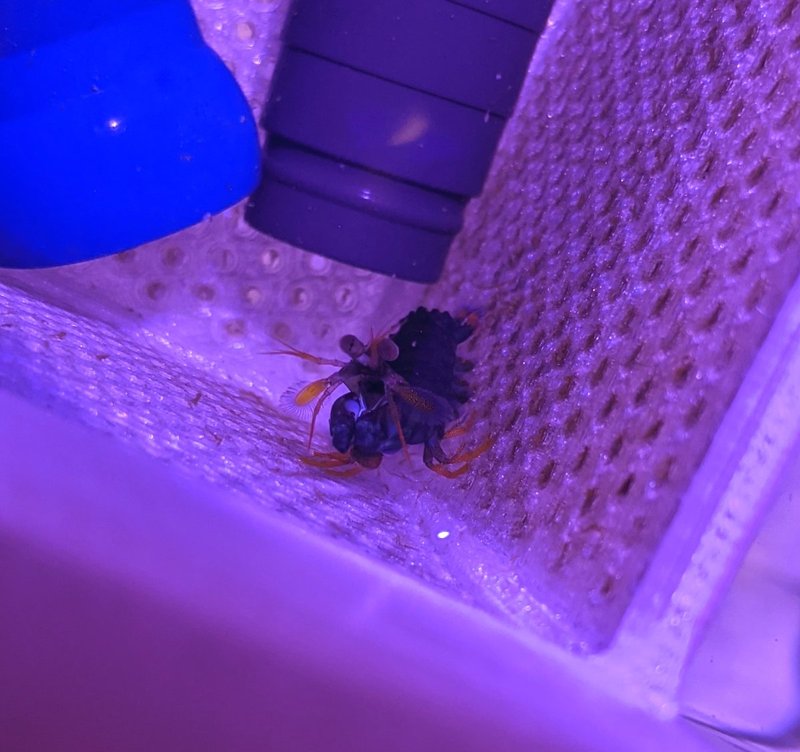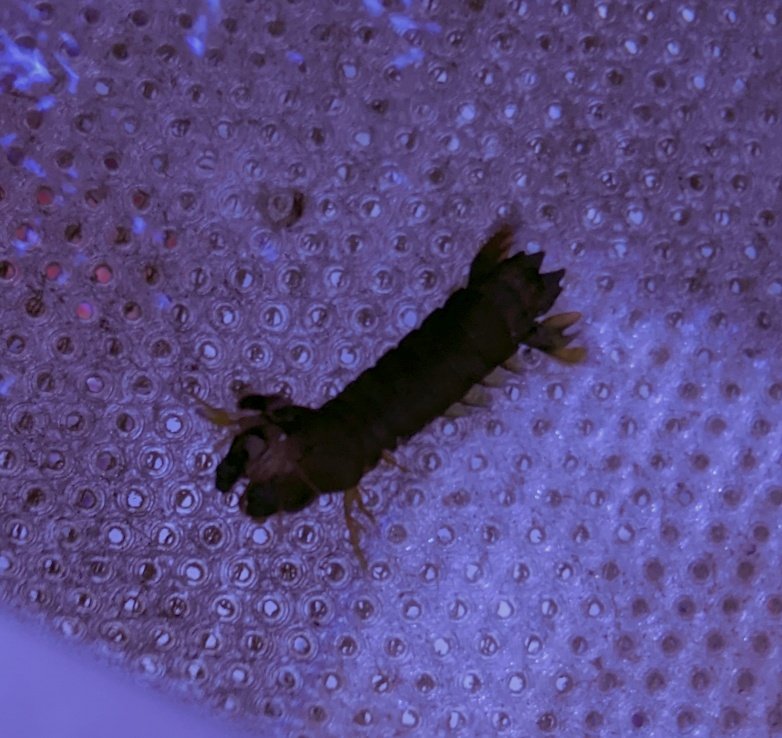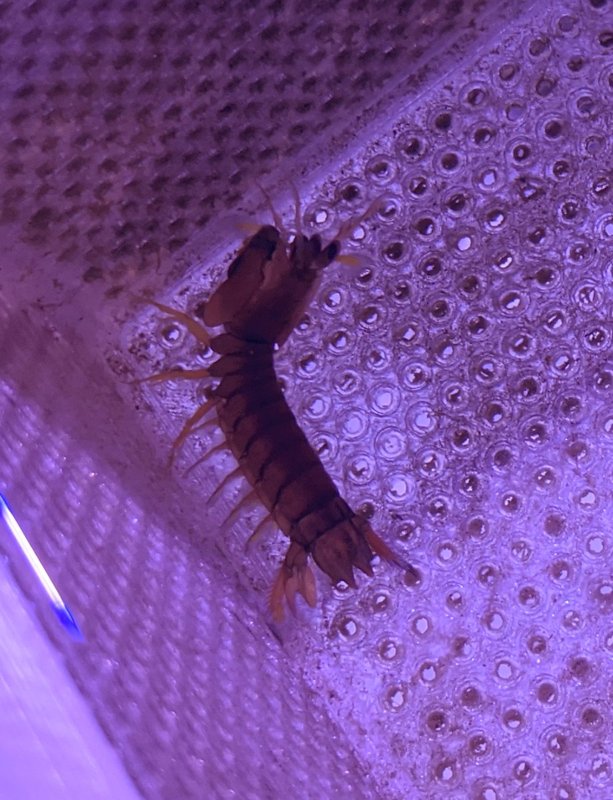-
Posts
748 -
Joined
-
Last visited
Content Type
Profiles
Forums
Gallery
Events
Store
Everything posted by DaJMasta
-
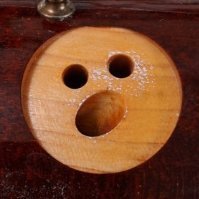
weird black or blue wrasse identification please
DaJMasta replied to Still_human's topic in General Discussion
It's a tough one, I wonder if coloration and even tail growth are an artifact of handling or age. While most pictures of cleaner wrasses really don't look a ton like this one, this image seems to at least be fairly close: https://www.whatsthatfish.com/fish/fourline-wrasse/2713 -

DaJMasta's 45G AIO Cube Mixed Reef
DaJMasta replied to DaJMasta's topic in Dedicated Tank (Build) Forum
So all sorts of things have been happening, among others... I have new corals (and anemones!) There has been some drama along with them that seems to be past me now, but I will save that for another post and stick with the more mundane here: Parameters seem to be fairly stable, and I'm still doing a few of them daily to make sure I have an eye on things. The skimmer continues to pull grime, I continue to overfeed somewhat to encourage things to eat, and the algae scrubber is finally doing something. A picture from Friday when I installed the new air pump (2.5 weeks of running), then a picture from this morning (5 more days) where there was enough growth for me to pull out the black mesh it shipped with to reduce light intensity for the initial bit of algae to sprout. The fish have all become somewhat bolder, the 'fraidy-cat still being the diamond watchman goby, now named Pops (because it looks like a popsicle), but even it's been seen nearly at the front of the tank, albeit only briefly and along one side. I was a bit concerned about Mandy (the mandarin) on Sunday so I caught her (I think it's a female, but the dorsal fin is rarely raised) to try and spot feed with prepared foods. Not a ton of interest in the container, but when back in the tank with the pumps off there's still a food response when feeding the tank, and she's trying it - had a full mysis in her mouth for 10 seconds or so before spitting it out. I was concerned because she doesn't really look better fed than she was in the LFS, so I wanted some visual confirmation of eating stuff in addition to pods - while that confirmation will have to wait, there's still a pod population and I've now got a mesh box that's well suited for that kind of training if needed. Then yesterday night I saw a yellowish sponge in a place I didn't remember having one, only to come back a few minutes later to it in a different place.... a third hitchhiker nudibranch species! A slow one, even in the tank, but another one of those fragile creatures that likely wouldn't have made the trip as a hitchhiker if it weren't for the quick shipment. New critters settling in (except for one rock anemone which refuses to root in a reasonable place), and a couple of equipment changes to get things all the way where I want them, but that will be another day. -
Saw a video of a big tank being installed and they called a local tank maintenance service to do it, since they were equipped and experienced with installing large ones. Can't vouch for any of the local ones and haven't done it myself, but it sounds like a reasonable line of inquiry, at least. Good luck!
-
Urchins can eat a lot and can also eat coralline and pickup and move corals around, but they can certainly do a good job. I find that some clean up crew crabs and snails will do a pretty good job when water parameters are good. A protein skimmer is not a requirement, but it can definitely help. Do you have any nutrient export systems in place? I say the vague version because that can be a skimmer, algae scrubber, refugium, or even chemical filtration (chemipure or something) or a heavy water change schedule. Having one or more of those will help keep the water clean while you continue to feed everything, which often speeds up growth or lets you keep things that have to eat regularly. I don't know what your testing capability looks like, but something like nitrate, phosphate, and alkalinity test kits in particular could be useful in troubleshooting water quality issues. The first two are big for nuisance algae and sort of general health, but the alkalinity test kit should help in particular for growing stony corals, since alkalinity is consumed more quickly than calcium and other elements when building their skeletons, so it can be a good measure of when to dose or do a waterchange to keep the needed elements up.
-

DaJMasta's 45G AIO Cube Mixed Reef
DaJMasta replied to DaJMasta's topic in Dedicated Tank (Build) Forum
A little update... found another nudi today, a new variety, and as best I can tell, not a known big pest. Got it under the microscope too: Otherwise, pH was a bit down today but everything else was stable (inside all day without the house circulation going much?), everyone seems to be fairly happy and the hair algae is gradually going away (thanks CUC!) Got the new air pump and installed it, hoping for real growth in the scrubber by the start of next week. Otherwise, that urchin I made a movie of is probably twice the diameter today as it was, and I've spotted two other urchins at a similar starting size... -

DaJMasta's 45G AIO Cube Mixed Reef
DaJMasta replied to DaJMasta's topic in Dedicated Tank (Build) Forum
A little update that's really more a continuation of the last post, albeit with a couple more days to monitor things. I don't have space for a proper quarantine, but I know about the risks of bringing new fish in and wanted to do something to mitigate them, so in looking around I stumbled on Safety Stop, a two part acclimation/dip before introducing the fish to the tank. None of the fish I had gotten had any visible signs of disease and were acting normally when I got them, but it's good practice to medicate and quarantine, so I went for it. Setup for the dip is pretty easy, you need a couple of buckets, a heater, an airstone with pump, and some extra water. I put the two buckets for the dip in a larger bin with some water (actually the wastewater from the initial drip acclimation) and the heater so I could keep both heated for the duration. The basic procedure is: Drip acclimate the fish to temperature/pH, they recommend about 30 mins and a driprate that makes that two doublings of volume in the container Catch the fish and put into the first dip - a gallon of tank water and the green part A of the packet - and let them sit in it for 45 minutes with the air bubbler going and monitor for signs of stress Then transfer the bubbler to the second dip - a gallon of tank water and the blue part B - catch the fish and transfer them to the second dip for another 45 minutes worth of monitoring From there I caught them again, briefly dipped them in some plain tank water (really to rinse the net and minimize medication in the tank) and released them into the tank. All told, the dip went great. It was fairly inexpensive, easy to do, and gives you a bit of prophylactic treatment even when you don't have the space or equipment for a proper long term quarantine. Maybe not safe enough for some, but definitely better than nothing and as much as I hope to need for this relatively small tank without any really expensive fish in it. I ended up doing the full 45 minutes worth of dip in each because the fish showed no signs of distress, though the diamond watchman goby jumped out two of the three times I tried to net it to get it to the next bucket.... The next morning, however, I found a problem, and it actually didn't have anything to do with the dip: the yellow goby had two parasitic isopods attached to it. The goby definitely didn't have them on it the day before and definitely acting less energetic than the day before, so I read up and prepared for treatment. I had actually seen a larger (half an inch or so) isopod in the tank that came in as a hitchhiker, but I've had isopods that were detrivores before and never bothered things, so while they always looked a bit creepy, I let it be. I also saw after a couple weeks in the tank a handful of very small isopods - maybe a dozen - after lights out when looking with a flashlight. None of the other fish have them (to this day, though I haven't been able to see the watchman goby up close yet because it's still mostly hiding in the back), and I think I have an explanation. Basically, the only time I've really observed the isopods is after lights out, near the front of the tank, where they sort of zip around near the glass. The yellow goby was the only fish to spend any time in that area of the tank on the first day, and actually perched for a bit on the front and side glass when moving around that first evening, so it may have just been in the wrong place when they were active and was latched onto. In any case, I wanted to act quickly because though the isopods were small, so was the goby, and the visible signs of stress are never good, especially after a new introduction and not a lot of feeding. It hid most of the day in places I couldn't get at, but around lights out it actually came back to the front of the tank to hunt, and I scooped it up in a net. I had read that a freshwater dip was the way to go, so I prepared some RODI with a bit of kalk to match the pH (very finicky, a pinch of kalk in a gallon or so of water is WAY too much, so I had to go back and fourth a few times diluting it and rechecking), a small heater, and the air bubbler. I gave the yellow goby four minutes in the freshwater bath, where it showed no signs of stress, and actually left it in the net for the duration, so I even saw the small dead isopods in the net at the end. I scooped the goby up in my hand and returned it to the tank, where it's been more active and healthy looking since. Knowing there were other isopods around, I had the baster at the ready with a very fine net (like the ones used for shrimp), and I managed to suck up at least four more of the little ones that flew around in the front of the tank after dark. I will be checking nightly for another week or so to get as many as possible, as well as monitoring the look of the fish, but last night I couldn't see any and there aren't new ones on the fish, so it's going well so far. If anyone knows their tank has isopods and wants to remove them, my recommendation would be to use a normal flashlight shortly after lights out with the flow on. Isopods do have characteristic shape and large eyes, but they're also strong swimmers, so they will zip around at a similar speed to worms in their larval stages, so they aren't too tough to spot. At least when they were initially spotted, they actually seemed to be attracted to the light, so a normal flashlight is probably better to something red or other method. Since that drama things have settled, the fish are still shy but venture out farther each day, I had a clam drop off of the rockwork and into an entrance to the shrimp tunnel overnight, so I moved it to a crevasse on the rock, and it climbed out and elsewhere over the next night. The fish are all eating well and the parameters are continuing, and thankfully my new air bubbler seems to be coming tomorrow, so I hope that algae scrubber will be working by the beginning of next week. -
Haven't actually tried it, but would hydrogen peroxide spot treating help with this? It's a large area for it, but zoas are pretty tolerant of it as a dip, so you may be able to get a fair bit of area covered with just squirting some on the algae covered portions. Probably not good to dip the whole rock because of the other potential stuff on/in it, though.
-

DaJMasta's 45G AIO Cube Mixed Reef
DaJMasta replied to DaJMasta's topic in Dedicated Tank (Build) Forum
The tank turned one month old today and quite a few things have been happening - most notably, I have fish! The sort of usual brown diatoms and green algae have come and gone a bit in the last few days - I actually cleaned most of the algae off the back glass and five hours later diatoms were all over the sand instead - but it seems when not significantly disturbed, they don't change a ton. A bit of manual removal persists, especially around the couple of corals I've got growing to prevent irritation, but I've been especially impressed with the nerite snails. I dropped them off on the little shelf on the right side and not only did they clean off a good patch, they did a pretty complete job of it. Complete enough that I moved a couple elsewhere to balance out the algae removal. Monday was the big day for fish, I picked up three from another club member then went to the fish store and my eyes lit up for two more - a very large bioload addition, but at least in the subsequent two days there have been no nutrient spikes - and all of the larger adult size fish, with the exception of the diamond watchman goby, were relatively young and small. I got the aforementioned diamond watchman goby, a yellow goby, a banggai cardinal, a juvenile flame angel, and a mandarin dragonet. Some perhaps ambitious stocking choices for a 45G tank, but from their behavior and peacefulness, I think I can be successful with them. The biggest concern is the mandarin, but there are a few things that suggested I could make it work: I have tons of pods in this tank. Between lots of mature live rock, dumping in the grunge from the end of the live rock bag, and three weeks without pod predators in the tank means they definitely multiplied - when the circulation and lights were out because of the power outage, I could see easily a thousand copepods on each pane of the glass with a flashlight. That gives me a starting food source, but what about continuing? I have a lot of rock with a lot of crevasses and a deeper sand bed that I won't be vacuuming, both of which will help, and then there should be some habitat in the algae scrubber in the back as well as some marinepure balls I intend to add to the media rack (will take time to get going). I also won't be using a filter sock, so there won't be manual pod removal and there will be somewhat more detrius for them to eat. Most importantly, I want to try to train it to eat frozen food. At the shop the staff dropped some frozen brine in and there was definitely an interested feeding response (not 100% sure I actually saw any consistent eating) for the mandarin I ended up taking home, whereas another the shop had didn't even pay attention when the same was added to its tank. Finally, the one I got was fairly small, so I have some extra buffer time to build up some pod production in the back compartment as well as train it to eat at least some prepared foods. I look forward to making it fat! Speaking of the algae scrubber, I haven't been wowed by its performance so far, but I think I've found out why. It's been in the tank just shy of two weeks and only has some brown (looks like the same diatoms) and a few specks of algae that made their way in there, but not real growth. I went looking around for recommendations and found that on one of the pages for the Drop 1.2x, the Tetra Whisper AP150 air pump is recommended.... one suitable for a 150G tank (whatever that means), whereas the one I had running on it was designed for a 10G tank. It would be much more helpful if manufacturers of air pumps (and Santa Monica Filtration, for that matter) published nominal air volume and pressure specs for their pumps reliably to give you an idea of the actual performance of the unit to see if it's suitable for your application. It seems like my pump was not at all suitable, so the recommended one is on the way. Maybe another week to go, but I'm hoping all that green algae on the glass and rocks can be taken up by the scrubber. Today my flatworm decided to take a tour of the tank with the lights on, unusually, and I caught a bit of it in action on video: I also spotted an odd anemone-looking thing grabbing particles from the water and after some research found that it's a filter feeder sea cucumber's appendages, so I squirted it with water and prodded at it to see how it would react. Yet another hitchhiker I didn't know came in three weeks ago! Oh, and it's worth mentioning: those striped anemones like the one bottom center on the video that I have probably a dozen of from the rock, they aren't warty anemones. They look the part, but they don't have the characteristic lines of bumps on the outside of the foot, so it seems they are most likely "light bulb anemones", which there doesn't seem to be a ton of information on, but which seem to be common on gulf rock and don't replicate with a speed that makes them a pest. -

DaJMasta's 45G AIO Cube Mixed Reef
DaJMasta replied to DaJMasta's topic in Dedicated Tank (Build) Forum
Thanks, it probably scales up well too, 2-3 bottles and a bigger pot would let you rotate and always have something warming the tank, though it starts becoming more of a stable job at that point, it could be viable for a larger tank. I had considered taking some tank water in a bucket, then warming it over a less-than-boiling pot, but the chance to cook whatever was in it and then dump it back in didn't seem like a great option, even if I could watch it to keep it from getting too hot. I went to teach this morning and spotted a not-before-seen nudibranch on the rockwork, so I sucked it up in a baster, put it in a bucket in the tank, and got it under the microscope. I think it's an Aeolid, but I don't have any real guess on the ID: -

DaJMasta's 45G AIO Cube Mixed Reef
DaJMasta replied to DaJMasta's topic in Dedicated Tank (Build) Forum
Thursday came and went without particular interest, then Friday came and my clean up crew had finally arrived! Two days late from the estimate on the label and a day later than tracking had said, but no casualties en route. I think I may have missed some nassarius snails, but I think I got enough bags so I think I just got five of another variety, and in usual ReefCleaners fashion, I bought like 6 dwarf ceriths and got around a heaping tablespoon. The new critters, my first intentional livestock aside from the first monti frag, were settling into their new life of eating stuff that looks bad in the tank, when the power went out. Friday was windy, but barely more than that, and I got my first test of my backup power options. The outage seemed pretty small, just a zig-zag through the neighborhood among a sea of normally powered homes, but it took 10 hours to come back. The 1500VA lasted almost exactly 3.5 hours with the return pump and a 50W heater on it - though I'm pretty sure the tank was warm enough that the heater was never really on. After a few minutes of setup, I rigged my eventually-to-be ATO pump, a Tunze osmolator pump, to a 12V sealed lead acid (I used a series diode to reduce the voltage a tad, but the pump says it's good to 12V), and got about 3 hours out of however full its charge was (cutoff the pump at 11.8V read under load, discharging too deep will permanently damage the battery). Towards the end of that time, I filled a 2 liter bottle with RODI (and a little air), and then cooked it on the stove (gas!) on low heat, also in a pot of RODI, until it was hot, then put it in the tank to try and keep it warm. I rotated it out of the tank and back into the pot every 20 minutes or so for a while, including after the pump was shut off. I tried to keep a tiny bit of flow going with a turkey baster and by moving around the bottle a bit, but it was sort of a token gesture more than it was probably effective. At almost 2am and with some people with flashlights finally showing up to look at the power lines, I went to sleep. The reality was I needed to work in the morning a bit and the stuff in the tank was about as hearty and understocked as it will ever be, so the tank sustaining dress rehearsal came to an end.... and I was woken up an hour later with all the lights coming back on and the tank starting to get back to normal. The next day comes, the final of the three mantises gets sent off to its new home, and the tank is basically back the same as ever. A bit of brown on the sand and more than a bit of green on the back glass, but on the track it was on before, at least. This coming week marks one month since it started and while I'm getting a bit of ugly phase while the clean up crew gets to work and the algae scrubber gets seeded, I'm keen on some proper stocking this week. I'll see from where and what - fish would be great, but there are some great looking corals around - but I definitely want to get something. -
Yeah, some kind of tunicate.
-
Made a short stand for something small out of a slice of PVC tubing, just drilled holes through the sides to get zip ties through and zip tied to the base of the thing it was supporting and is secure enough - would probably take 4"+ PVC for an appropriate size for a skimmer though. As mentioned PVC, acrylic, and plexiglass are all going to be fine but can be varying degrees of annoying to work with, depending on what you have to do. If you have a 3d printer, PETG or other PET based filaments should probably be the go-to, but a lot of plastics can work provided they aren't pigmented with stuff that leeches out. ABS and similar plastics will likely work fine, but usually float, so they're annoying to use for some things. I'd probably go to the hardware store and look for something made of plastic that's approximately the size/shape you're looking for and just go with that. I know there are some large size PVC flanges and adapters that may be around the right height and should be pretty easy to cut (though you want the cut to be level or the skimmer will rock), but maybe like a bundle of appropriate length fittings or pipe segments would be a better choice. I'd probably go with something with a bunch of holes in it just so you don't loose the water volume, but you're looking for something that's totally inert in the long term when immersed in saltwater, which is most typically plastic. Come to think of it, maybe the most expensive/interesting way to do it would be to stack up a few blocks of marinepure or similar under it. Really optimize that sump space.
-

DaJMasta's 45G AIO Cube Mixed Reef
DaJMasta replied to DaJMasta's topic in Dedicated Tank (Build) Forum
Today I shipped off the first and the second of three mantises! Traded one of them for the very first frag for the tank, a bit of bubblegum digi that was described as "bulletproof"... and which lived up to its name by having a bit of polyp extension sitting in the plastic bag it was handed off in, and then coming out something like half way within just an hour or so in the tank. It's the little bit sticking out on the left! Today also marks the first day I'm not testing daily for normal cycling parameters.... because ammonia and nitrite have been zero for a couple weeks now. Nitrate and phosphate are higher than I'd like, and I'll maintain testing as the algae scrubber comes online, but it's nice to be progressing. The green algae on the rocks is starting to come in a bit more, not in more places, but lengthening for sure, so I'll be happy to get the scrubber taking up some of that and the clean up crew (maybe tomorrow, maybe delayed a day by the postal service?) In the interim, a little manual removal on longer bits and around the corals that could be bothered will have to suffice. Speaking of, one of the montastraea that came as a hitchhiker and looks particularly photogenic was the first thing I pointed my new camera lens at... and it does not disappoint! Now that things are starting to be settled and the routine seems to be going along, I've turned my sights to what potential stocking I want to have... and while the list needs to be narrowed down and certainly won't be added all at once, since I may have fish inside a couple weeks, I want to know what trajectory I'm going for. As I do want some ornamental inverts, everything's got to be reef/invert safe, and since everything will be frag sized for a while yet, potential coral nippers may have to be delayed a while. Right now, I'm considering: Flame angel (never had anything this large, wouldn't be against trying something else of similar size) Rainford's goby A pair of clowns maybe? Maybe only if I find a bigger nem for them Atlantic sailfin blenny Mandarin dragonet (a definite priority, but one that needs some time or needs to be captive bred) Hector's goby Diamond watchman goby (a few of the shrimp gobies would be good choices, I think this is my favorite look, and I've definitely still got a pistol shrimp for it to pair with) A few chromis (green, Caribbean blues?) - some other small damsel would be neat, but it seems like none are going to leave other critters alone A yellow cucumber (everwhere I see lists as a filter feeder, which I should be able to support given the multitude in the tank now, but Ideally I want a smaller sand sifter, and I've seen these sift sand before) A fire cleaner shrimp or two Maybe some sexy shrimp? The list is too long, but I think those are all generally peaceful enough to fit the bill, so I'm looking forward to sorting through the options and getting some real movement in the tank. -
They may have a video on their youtube about this, there are a good few of them, at least. While I don't have a BRS specific one, unless you're dealing with float switches shutting off the input or the like, the overall path of water is pretty similar across systems: Feed line -> on/off valve (if you have it) -> prefilter -> carbon block (or more than one) -> RO membrane input Then on the wastewater line from the RO you put the flow restrictor, then to the drain On the RO output line you run into your DI stage(s), and then you have your output line
-
Is the big acrylic tank listed here your size? Could be worth asking after for the ease of care/scratch issues of acrylic too.
-

Howaboutme's Return - Waterbox PM15 UNS 75s
DaJMasta replied to howaboutme's topic in Dedicated Tank (Build) Forum
Great looking rock nems! -
I don't have a maker to recommend, but maybe there is another manufacturer that makes an equivalent sized tank by default. With a little googling around, it seems like the 84x24x24 is a size that some make as a 200G, but there's at least one maker doing stands for the 30 inch high configuration. I think Perfecto is the same as Marineland, and that seems to be the ready-for-purchase options I see, but would you consider acrylic? There are a few online places that do custom acrylic and advertise similar sizes of their standard options. Just thinking that if you got a tank from somewhere either with stock or with a big enough operation to do advertise custom orders with a substantial stock that they would have a shorter turnaround time.
-

DaJMasta's 45G AIO Cube Mixed Reef
DaJMasta replied to DaJMasta's topic in Dedicated Tank (Build) Forum
Thanks! There is definitely something..... creepy? about them. I think it's that they mostly hide like other things, but when they're feeling more comfortable they can be quite bold and quick, and seeing them run around on the rocks hunting is interesting because they can do that bug thing where they run in a straight line at normal speed while running over the underside of a rock, so they can sort of spring up on the other side quickly. The tube anemone I'm trying to train to be out during the day (daytime direct feedings), but it still prefers night time, so under the moonlights I used a flashlight to snap a picture: Under the sponge covered rock you can see that flatworm I spotted last week, it's still alive and kicking and best I can tell, it's a Pseudobiceros splendidus, which has some confirmation that it lives in the Gulf and it eats tunicates, which are still pretty plentiful on the rock. Hope it can stick around. While I haven't yet properly spotted it, I definitely have another digger in the tank after isolating the mantises, and I'm hearing some snaps that aren't hits on the plastic boxes (and after dark when the mantises aren't active) that suggests that it's probably that pistol shrimp I saw adding the rock initially. I've shined a light down the hole a few times and saw whiskers or an eye, but never enough of a body to confirm what it is for sure. Did a 5G water change today and will probably do one every other day or so for the next week, nutrient levels are still high and there is actually still some amount of a dieoff - I think it's specific kinds of sponges, but there are some that seemed to either hate being exposed to air or were physically damaged in transit, so while most of the encrusting sponges seem fine, some things are still flaking off a bit. Ran a full panel (all the test kits) of water tests today and the phosphate and nitrate are up a tad, suggesting that the day or two without a water change did have some effect, albeit a small one. No visible algae seeded in the Drop 1.2x yet, but I assume I'll see at least some in the next few days. A bit more green growth on the dry rock, but still not dense or fibrous growth. I bought a strontium kit because it was cheap and I was curious, but I don't know if I did it right. I got to the Calcium readout part seemingly fine, and it agreed with an earlier calcium only test, but when waiting for the next portion, the solution seemed to separate/precipitate. When I did the final titration stage, it took more drops than were on the chart to get a strontium reading (0.13mL, which on the scale given is like -5ppm Strontium haha), so I'll have to give it another shot at some point and see if I can get a usable baseline. Things continue, and plans for the future continue to mull around.... we'll see what comes to fruition and when. -

DaJMasta's 45G AIO Cube Mixed Reef
DaJMasta replied to DaJMasta's topic in Dedicated Tank (Build) Forum
Just a little update for a new FTS, gradually getting a feel for making white balance work. I didn't do a water change last night, first day without one, and all the parameters are about the same today. No growth on the Drop 1.2x, but that's expected, did a little more small scale cleanup but nothing big, and put in the battery backup to help with short term power outages - will test for runtime at some point, but haven't yet. The mantises are getting bolder in exploring their boxes, and there is a chorus of snaps in the daylight to twilight hours with them smacking on the box or the fittings in it, but no signs of damage - the softer plastics seem to hold up much better than harder, more brittle shells and things. Feeding them a bunch of mysis every other day and they take them eagerly enough - all three hide when I open the tops, but today all three had eyes peering out when I went to feed them, whereas last time all three were fully hidden, and the first mysis that gets down near them gets snatched into the hiding spot to be consumed. Given the unchanging parameters, whatever cycle I may have had, I'm willing to call over, here at like 2.5 weeks from the first water. It's definitely not fully settled, and nitrate and phosphate levels are a bit high, but I'm getting little growth of those nasty-stage organisms that make the rocks dark, the diatom 'bloom' was never that bad and has mostly subsided, and there's a bit of green algae on the dry rock, but the only stuff on the established rock is what it came in with. With that, I placed an order for a bit of a clean up crew to arrive next week, and hopefully I'll have a couple of corals or fish in first week of May, provided everything still looks normal. Gotta get moving on the controller design soon enough, but since it's very central in the house and I don't have vacation coming up, manually managing things shouldn't be too bad for a bit. -

DaJMasta's 45G AIO Cube Mixed Reef
DaJMasta replied to DaJMasta's topic in Dedicated Tank (Build) Forum
Today was much less remarkable in the tank, but there's some notable progress. I hit a few aiptasia last night with some kalk paste, and so far they seem to be done with, though I suspect there will be more to find yet, not sure if they were on the new rock or maybe just the original LFS live rock, but I knew there were a few around, so good to do. Today I had a new filter arrive, a Santa Monica Filtration Drop 1.2x, and dropped it in the back. Not really having the space for a refugium, I had looked into turf algae scrubbers for a bit to augment the skimmer, and while the Drop series seemed like an ideal form factor, they're at least 50% more expensive than they probably should be. I looked at other options and nothing was really the right size for my tank (relatively narrow rear chamber, no external plumbing, close to the wall), so I eventually just went for it. I toyed with DIYing it as well, but with a dark back glass pane, external lights would be harder to install and would need glass cleaning (annoying in the narrow back chamber), and the submersible high power red LEDs are not that available so they're quite expensive to just buy on their own. The unit is a perfect size for the top of the media rack in the back, and with a fairly quiet air pump, it's not noisy so long as you keep the water level a little below the hole in the top of the unit. Still waiting on a timer for the internal lights, but with the air and LEDs on for a few days, I hope to get it seeded well enough that it starts proper operation next week. After lights off I spotted a new likely hitchhiker, what appears to be a tiny rock boring urchin. Not 100% on the ID, but it has spines in all directions that move independently, but it's only like 4mm across or something, very small and it was only today that I even spotted it. In any case, got it on video, sped up 8x, so that the slight movements are clearer. Oh and I missed this when it was first posted, but this is the non-corner version of the printed isolation boxes I'm using for the mantises: https://www.thingiverse.com/thing:4834450 The original one also has a lid added to the thing page - important since these mantises will try to poke their heads above the waterline. -

DaJMasta's 45G AIO Cube Mixed Reef
DaJMasta replied to DaJMasta's topic in Dedicated Tank (Build) Forum
Interesting, got the three under the microscope and had a look - much better representation of color, and honestly, they all look like about the same species - at least, I have difficulty telling them apart aside from coloration. Since they were out of the display, I redid the rockwork today and actually glued a few bits (though they don't seem that secure since half the gluing was underwater and the epoxy has never felt super secure before curing), and while it still does look fairly generic from the front, there's a good bit of depth from the camera, and at least this version has a good number of overhangs and little nooks for things. Also managed to get the rock with the tube anemone and my favorite of the hitchhiker LPS on it right in the front. Also spotted a baby pistol shrimp today (maybe half an inch long) and removed just a bit of green algae on the top of a rock. Hopefully over the next few days the more stable rockwork and placement will mean some settling in for the creatures in there. I still am seeing the black flatworm sometimes, and I've seen both starfish legs sticking out of holes most days. Lots of copepods on the back glass spotted in the moonlighting, and I think I even spotted a tiny nassarius on the glass after lights out (maybe 3mm long, tops). Took an FTS after the water cleared, under just the moonlights. Aside from the reflection of a clock and a couple of hot pixels, I think it's a pretty good representation. -
Nice shrimp! That tiger pistol is pretty big, do you know if they get any bigger?
-

DaJMasta's 45G AIO Cube Mixed Reef
DaJMasta replied to DaJMasta's topic in Dedicated Tank (Build) Forum
Still haven't figured out white balance, but took some pictures that sort of show the color differences between the three: The reddish (orange, maybe?) one: Has some of those darker areas along the plates, but I feel like it's less obvious in person and it's a little lighter looking than the picture shows. The blue one with orange legs: Definitely my favorite looking of the mantises, and the one that seems to hammer on the holding box more than the rest, but also the most curious when I open the top and start looking (I had to take out the fittings in the other boxes to get the others to come out, this guy just started looking up). There are some whiteish/light blue dots or bloches on that forward carapace, but the segments behind are all fairly uniform and dark blue overall. And the green one: Looks lighter and slightly greener in person, but it's a darkish not especially saturated, so it's harder to just pick an overall color for it. There is a little color variation near the face that doesn't come through on the picture, but it's not especially defined or intense. Apologizes for the grime, I think the fine texture of these printed boxes plus the recent diatom presence has made them look pretty grimy. Last night/this morning I see just a little patch of green algae on some of the originally dry rock, but the diatom bloom is all but gone. Got a first redo of the scape but nothing glued, I think the direction is good, but I want to redo some bits and glue some things down. Trying to aim for a couple more slight overhangs to make it look more interesting while not just shading the whole bottom of the tank. -
Good luck with the treatments! Glad hydrogen peroxide is possible to find in the stores again...
-

DaJMasta's 45G AIO Cube Mixed Reef
DaJMasta replied to DaJMasta's topic in Dedicated Tank (Build) Forum
Managed to catch number 3! Not a lot of info on species, I've been looking around at species lists for the Gulf and haven't found a match for any of them, though in all probability there's just a good bit of color variation and they're all similar species or closely related. I'll try to get some pictures tonight in the baskets with proper white balance. I wonder if I could even get a microscope shot of each. All three are smasher type, all three have a similar body type, and all came from the same location. The smallest one is dark blue with orange legs (about half way up, like socks) and orange antennae - very spiffy looking - and is about an inch and a quarter long. This one was the most relaxed of them, sticking to its hole in a rock most of the time and investigating things that came by, but since putting it in a box on the side of the tank, it's been making the most noise (hitting the fittings in there for cover and the side of the box) and moving around the most - prompting me to design print a cover for the boxes. The first one I caught is maybe just under two inches long, is reddish tan all over, and is the most timid seeming of the bunch - it was chased up the back glass and caught in a net while hiding on a powerhead. I managed to get the third one this afternoon, and it's very slightly bigger than the red/tan one, it has a more mid tone body with blues/greens but not intense ones, but in the bucket it looked darker than expected - will have to get a good picture. It was the aggressor in the tank and moved around the rockwork the most, but has been pretty relaxed in its box so far. I'm slowly leaning towards that hatching event last Thursday being the young of one of the mantises in the tank - I've looked around at some other nauplii images for stomatopods and it seems like some do have those big arms visible, so it they certainly could have been mantis babies - and if I were to guess, they were probably the kids of the largest mantis. I found that one last and they are somewhat known for brooding behavior - since that one and the reddish one have fought, they probably aren't a pair, but while I didn't see the smallest one with either of the others for any real amount of time, there is some chance there is a pair among them. Could be hard to tell which short of introducing them to each other, and while the male is the smaller of the adults, I have no gauge whether the smaller one I have is a male or is just younger. All in all, I don't really see the variation in color on the plates with any of them that would suggest a peacock mantis to me, but body type and smasher look about right. I think at least one is adult sized, so I wouldn't expect it just to be juvenile coloration.



